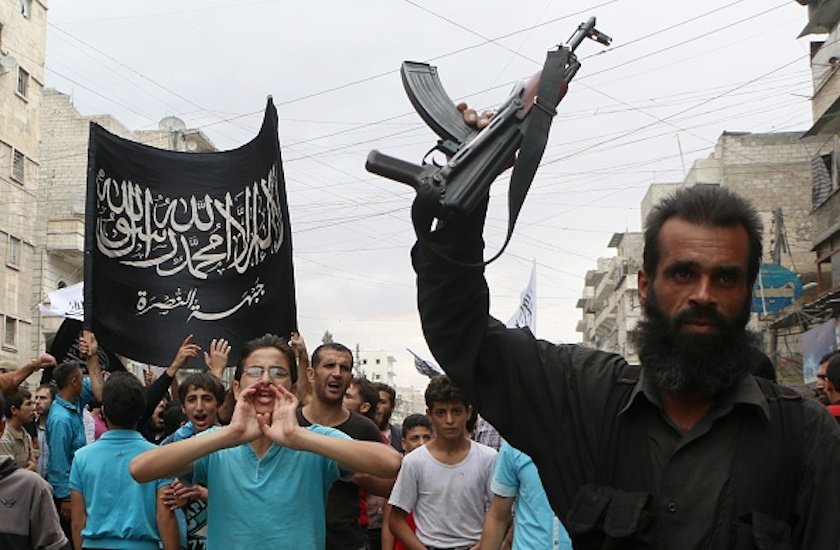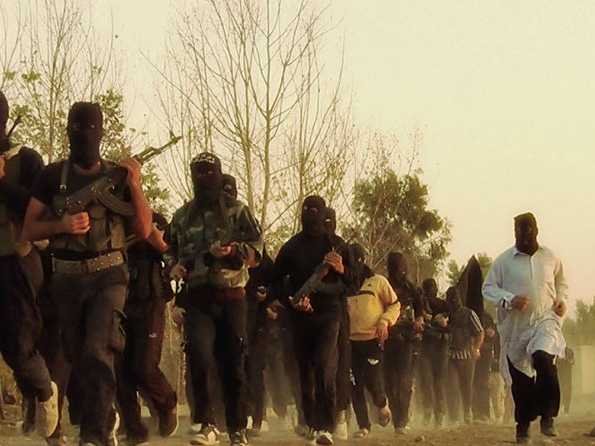Israel Is Cautiously Arming Syria’s Rebels — And Has a Fragile Unspoken Truce With an Al Qaeda Affiliate
MIDDLE EAST AND NORTH AFRICA, 13 Oct 2014
Ehud Yaari, The Washington Institute For Near East Policy – TRANSCEND Media Service

Fadi al-Halabi/AFP/Getty ImagesSupporters of the Al Nusra Front take part in a protest against Syrian President Bashar al-Assad and the international coalition in Aleppo on September 26, 2014.
In recent weeks, a new situation has emerged in southern Syria, one that could present dangers to Israel but also significant opportunities to help shape the area’s future.
Many observers still perceive the south as merely a secondary front in the ongoing civil war, but this view ignores the potential for drastic change there in a matter of months. In particular, the southern governorates of Quneitra and Deraa could become either the latest territories captured by radical forces — namely the Islamic State of Iraq and al-Sham (ISIS) and al-Qaeda affiliate Jabhat al-Nusra (JN) — or a safe haven for non-Islamist rebel groups, some of which maintain contacts with Israel.
Given these rapidly changing developments, Israeli strategists are quietly considering their options. The main question is whether to stay the course of limited involvement in the frontier fighting or be more proactive in influencing the outcome.
The Collapse of the UN Peacekeeping Force
Thus far, rebels have gained control over most of the territory adjacent to the 1974 Israeli-Syrian Truce Line, including the narrow demilitarized “Area of Separation” overseen for the past forty years by the UN Disengagement Observer Force.
UNDOF was originally established by the Security Council to supervise Israel and Syria’s adherence to agreed limitations on their border deployments, but as a result of rebel advances it has now practically ceased to function except in a small remote sector on the slopes of Mt. Hermon.
Its forces have abandoned bases and a string of other positions in Syria and discontinued inspections there. Meanwhile, UNDOF’s fundamental purpose on that side of the border — monitoring the Syrian army’s order of battle — has become largely moot because the Assad regime’s frontline 61st and 90th Brigades have completely collapsed.
In short, a border regime that fostered decades of quiet and stability may be reaching its end. The Area of Separation has been taken over by rebels who are not committed to the 1974 agreement, and the Syrian regular units that used to prevent border incidents have been pushed back.
Israel has new neighbors across the fences and ditches of its Golan border, including JN elements dedicated to al-Qaeda’s vehemently anti-Israel doctrine.
Israel Has An Undeclared Truce With An Al Qaeda Affiliate …
Under the current conditions, Israel is obliged to review its policy toward Syria on a daily basis, investing significant intelligence resources to keep up with the ever-changing military and political landscape. No major flare-up has occurred thus far, except a few sporadic incidents in which the Israel Defense Forces launched Tammuz missiles against Syrian army positions that had fired stray shells inside the Golan.
In addition, a Syrian fighter plane was shot down on September 23 when it mistakenly crossed into Israeli airspace while trying to block further rebel advances. But so far there have been no exchanges of fire between Israeli forces and rebel units of any stripe.
For its part, JN has avoided any attempt to engage in terrorist operations against Israel. The group’s southern units include very few foreign jihadists — most of its volunteers in the area were locally recruited. Indeed, the group seems to have decided not to get involved in clashes with the IDF for the time being.
Its cadres prefer loose, ad hoc cooperation with other rebel factions, including those with ties to Israel. Contrary to some reports, JN controls only a tiny stretch of land in the immediate vicinity of the border, although its members are present on some hilltops further east from which it would be possible to target the Golan.
Regardless of JN’s current posture, Israel cannot ignore the potential long-term threat posed by the group, nor can it turn a blind eye to the possibility of ISIS fighters infiltrating the area from the Euphrates Valley strongholds of their self-styled “Islamic State.”
Until now, the Israeli government has decided against taking preventive action across the frontier to repel al-Qaeda affiliates or disrupt their military strength. This cautious policy has been maintained even in light of the U.S. and allied campaign to “degrade and ultimately destroy” ISIS, which has included attacks on Jabhat al-Nusra (JN) targets.
Israel was not invited to join that campaign, and its undeclared truce with JN remains in effect. Yet it may soon have to reconsider that course.
… And Is Helping the Moderate Rebels
Israel’s most urgent question is whether to switch to a bolder, more proactive strategy vis-a-vis the Syrian war. So far, most Israeli support for moderate, local, non-Islamist rebel battalions along the border has been limited to humanitarian aid, such as treating 1,400 sick and wounded Syrians in Israeli hospitals, supplying medication, food, and heaters to villagers, and so forth.
Some rebel groups maintain constant contact with the IDF, including frequent secret meetings reportedly held in Tiberias, but only a modest amount of weapons have been provided to them, mainly rocket-propelled grenade launchers.
Within the next few months, however, a wider scope of military aid may prove necessary as these non-Islamist battalions — composed mainly of local youths — fight to defend their supremacy in the south against JN and ISIS. An upgraded support program could also help draw many fighters away from JN, particularly those who hail from local towns and do not necessarily share al-Qaeda’s ideology.
In view of the recently announced US decision to arm and train moderate rebels, Washington and Israel — and hopefully Jordan too — could seriously begin exploring the option of directing some of this effort to southern Syria.
This region offers training grounds, a significant number of non-Islamist fighters, and armed tribal groups in the Leja area. From a military point of view, moderate rebel groups could feasibly link Deraa on the Jordanian border to Quneitra on the Israeli border by capturing the main southern highway leading to Damascus. Their capture of Tal Harra over the weekend demonstrated their momentum toward this objective, and fully achieving it would create a buffer against ISIS and a springboard for a future offensive toward the capital.
If this “Southern Option” is contemplated in earnest, enlisting Jordan’s assistance would be very important.
In the past, King Abdullah has rebuffed Saudi pressure to use Jordanian territory as a corridor for arms supplies to the rebels. Yet Amman may reevaluate that position if it were approached by Washington for an American-sponsored program.
Jordan shares the same interests as Israel: preventing extremist Islamist militias from entrenching along its border with Syria, and seeing the downfall of the Assad regime. Given proper assurances, Amman might be convinced to cooperate in building up a substantial rebel force in southern Syria.
Any such effort must also include ironclad guarantees to the Druze population in Syria’s southeastern al-Suwayda province that they will not be overrun by the predominantly Sunni rebel militias. Israel and Jordan have traditionally maintained good links to the Mount Druze area northeast of Deraa, where support for the Assad regime has weakened over the years. Once their concerns are addressed, the Druze may adopt a neutral stance as long as they are not exposed to attack.
Solving the Southern Puzzle
The prospects of the current anti-ISIS campaign would be greatly improved by incorporating southern Syria into the battlefield equation. Together with the United States, Jordan, and others, Israel should explore the possibility of more fully transforming this area into a territorial base for moderate rebel forces.
And on the Golan frontier, Israel needs to reconsider its prudent policy and help prevent the “ISIS-zation” of areas bordering the Golan or the emergence of “Nusra-stan” there.
All of the relevant actors have a common interest in taking coordinated action in the south. Assad’s army has proven incapable of regaining lost ground in this region, the birthplace of the insurgency, and moderate opposition forces could find it to be one of the best areas in which to get organized.
_____________________________
Ehud Yaari is a Lafer International Fellow with The Washington Institute and a Middle East commentator for Israel’s Channel Two television.
This article originally appeared at The Washington Institute For Near East Policy. Copyright 2014.
Go to Original – businessinsider.com
DISCLAIMER: The statements, views and opinions expressed in pieces republished here are solely those of the authors and do not necessarily represent those of TMS. In accordance with title 17 U.S.C. section 107, this material is distributed without profit to those who have expressed a prior interest in receiving the included information for research and educational purposes. TMS has no affiliation whatsoever with the originator of this article nor is TMS endorsed or sponsored by the originator. “GO TO ORIGINAL” links are provided as a convenience to our readers and allow for verification of authenticity. However, as originating pages are often updated by their originating host sites, the versions posted may not match the versions our readers view when clicking the “GO TO ORIGINAL” links. This site contains copyrighted material the use of which has not always been specifically authorized by the copyright owner. We are making such material available in our efforts to advance understanding of environmental, political, human rights, economic, democracy, scientific, and social justice issues, etc. We believe this constitutes a ‘fair use’ of any such copyrighted material as provided for in section 107 of the US Copyright Law. In accordance with Title 17 U.S.C. Section 107, the material on this site is distributed without profit to those who have expressed a prior interest in receiving the included information for research and educational purposes. For more information go to: http://www.law.cornell.edu/uscode/17/107.shtml. If you wish to use copyrighted material from this site for purposes of your own that go beyond ‘fair use’, you must obtain permission from the copyright owner.
Read more
Click here to go to the current weekly digest or pick another article:
MIDDLE EAST AND NORTH AFRICA:
